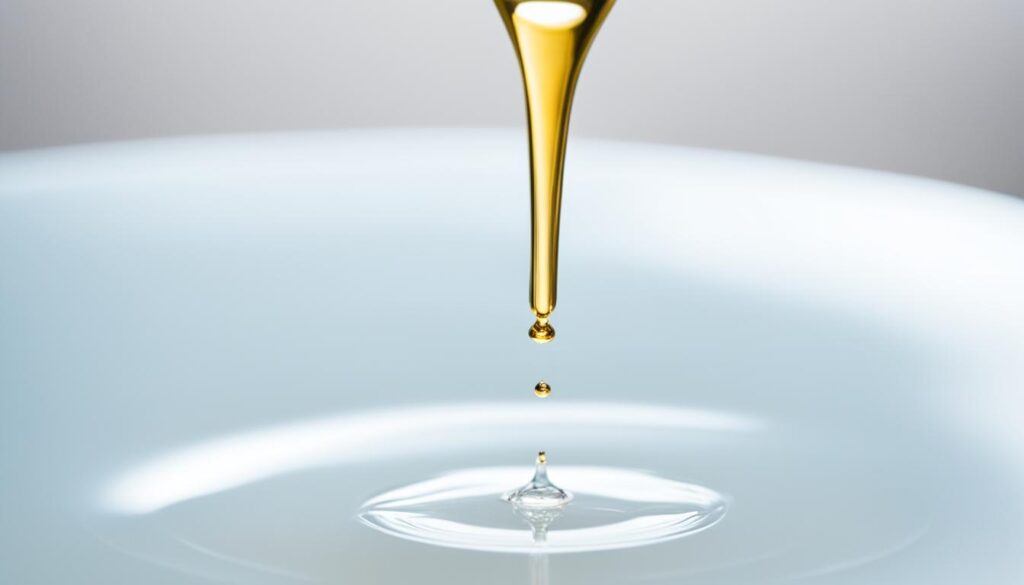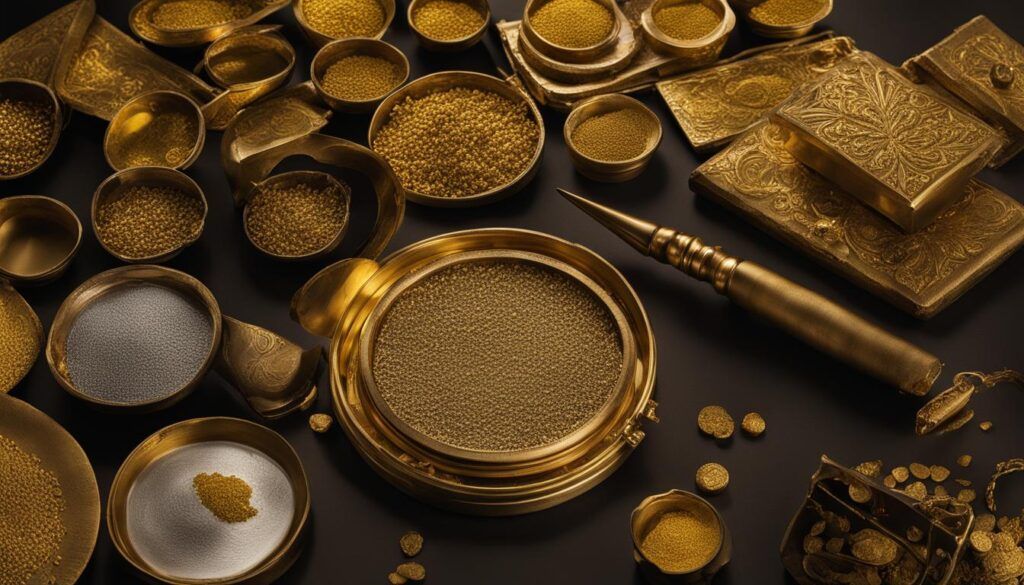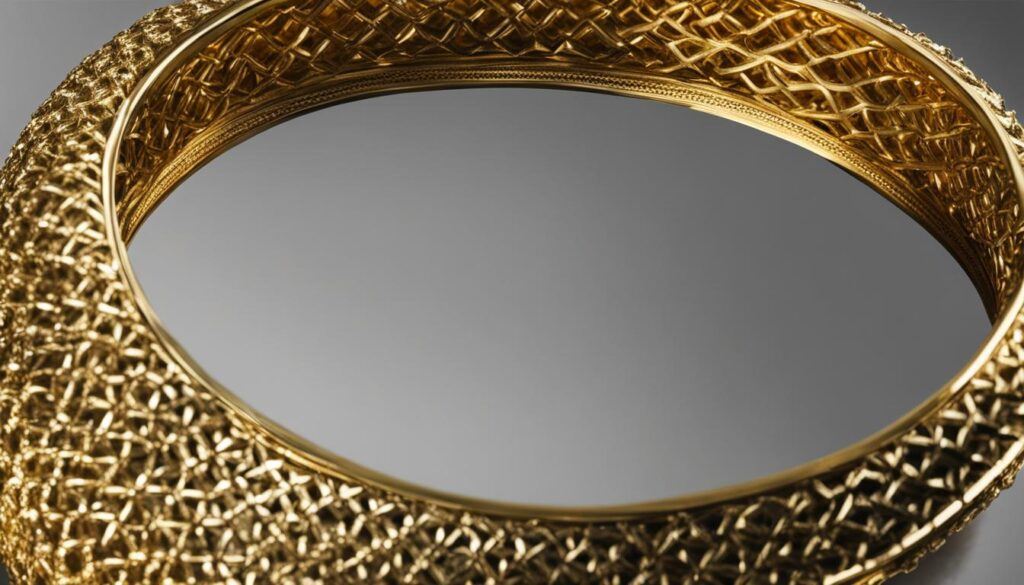As a lover of Indian gold, it’s important to make sure that the pieces you own or plan to purchase are authentic. With the demand for gold in India, there is also the presence of fake or counterfeit gold in the market. To ensure that you have genuine Indian gold, it is essential to know how to distinguish real from fake. In this Indian gold authenticity guide, I will provide you with various methods to determine the purity and authenticity of Indian gold.
Key Takeaways:
- Understanding the importance of hallmarks and their role in identifying real Indian gold.
- Decoding letter markings on Indian gold jewelry to differentiate between real gold and gold-plated pieces.
- Conducting skin tests and checking for discoloration to authenticate Indian gold.
- Using the water test and magnet test as additional methods to identify real Indian gold.
- Exploring the vinegar test, scratch test, and density test to further determine the authenticity of Indian gold.
The Importance of Hallmarks in Identifying Real Indian Gold
When it comes to determining the authenticity and purity of Indian gold, hallmarks play a crucial role. Hallmarks are engraved stamps found on gold jewelry, providing valuable information about its quality and origin. In India, every piece of gold jewelry is typically engraved with a hallmark stamp, making it easier for buyers to identify genuine gold.
These hallmarks serve as a mark of quality assurance and provide essential details about the purity of the gold and the manufacturer’s identity. For Indian gold, purity is measured in karats or millesimal fineness, indicating the proportion of pure gold in the alloy. Each karat represents 1/24th of the total gold content. Therefore, a hallmark of 24k signifies that the jewelry is made of 100% pure gold, while 22k denotes a composition of 91.6% gold and 8.4% other metals.
“Hallmarks are like fingerprints that can reveal the true nature of Indian gold jewelry.”
Authentic Indian gold will have hallmarks that adhere to the standard purity numbers, such as 24k, 22k, 18k, etc. These hallmarks guarantee that the jewelry meets the established purity standards. However, it’s important to exercise caution, as counterfeit gold can also bear fake hallmarks, tricking unsuspecting buyers into purchasing fake jewelry.
While hallmarks provide valuable initial information, relying solely on them is not enough to confirm the authenticity of Indian gold. Other tests, such as conducting skin and magnet tests, performing density calculations, and examining letter markings, should be performed in conjunction with checking hallmarks.
| Hallmark | Purity | Description |
|---|---|---|
| 24k | 99.9% | The highest purity level, indicating pure gold |
| 22k | 91.6% | Contains 91.6% gold and 8.4% other metals |
| 18k | 75% | Composed of 75% gold and 25% other metals |
Decoding Letter Markings on Indian Gold Jewelry
In addition to hallmarks, Indian gold jewelry often features letter markings that provide valuable information about the piece. These letter markings can indicate various characteristics of the jewelry, including its composition and construction.
Common Letter Markings on Indian Gold Jewelry
- GP (Gold Plated): This marking suggests that the jewelry is coated or plated with a thin layer of gold over a base metal.
- GF (Gold Filled): The GF marking indicates that the jewelry is made by bonding a layer of gold to a base metal, creating a more durable piece compared to gold plated jewelry.
- GEP (Gold Electroplated): This marking is used for jewelry that has undergone an electroplating process, where a layer of gold is applied to the base metal using an electric current.
It is important to note that jewelry with these letter markings is not entirely made of gold. Instead, these markings suggest that the piece is either gold plated or composed of a base metal with a thin layer of gold on the surface.

Testing Indian Gold Through Skin Contact
A simple yet effective method to determine the authenticity of Indian gold is the skin test. By conducting a skin test, you can easily identify whether the gold is real or fake by rubbing a piece of gold jewelry against your skin and observing any discoloration or marks left behind.
Real gold will not leave any marks or cause any discoloration on your skin. It retains its color and purity, without any adverse effects on the skin.
However, if the gold is fake or of lower quality, it may cause your skin to turn black, blue, or green. These discolorations are a result of the metal alloys or impurities present in the fake gold. This test is particularly useful for determining the authenticity of Indian gold, as it allows you to assess the purity of the gold based on its reaction with your skin.
It is important to note that while the skin test can provide valuable insights into the authenticity of Indian gold, it may not always be foolproof. There are instances where certain individuals may have a reaction to genuine gold due to sensitivities or allergies. Additionally, some counterfeit gold may be carefully crafted to mimic the appearance and reaction of real gold, making it more challenging to detect through this method alone.
For a comprehensive assessment of the gold’s authenticity, it is recommended to combine the skin test with other tests such as checking for hallmarks, performing density tests, or using a magnet. By utilizing multiple tests, you can ensure accurate results and make an informed decision regarding the authenticity of Indian gold.
The Water Test for Authenticating Indian Gold
One of the reliable tests to determine the authenticity of Indian gold is the water test. By conducting this test, you can observe the behavior of the gold and gain insights into its authenticity.

When performing the water test, you simply drop a piece of gold into a container of water and carefully observe its reaction. Real gold, being a dense metal, will sink to the bottom of the container due to its high density. On the other hand, if the gold floats or remains suspended in the water, it is likely fake or of lower purity.
The water test is based on the principle of gold density. Real gold has a density of approximately 19.3 g/mL, which is much higher compared to other metals. This high density enables it to sink in water, distinguishing it from less dense materials.
It’s important to note that although the water test can provide valuable insights, it may not always be conclusive on its own. To ensure accurate results, it is recommended to use the water test in conjunction with other tests such as checking for hallmarks, conducting skin and magnet tests, and evaluating gold weight and purity.
By utilizing a combination of tests, including the water test, you can effectively authenticate Indian gold and distinguish between real gold and fake imitations.
| Test Method | Result |
|---|---|
| Gold Sinks to the Bottom | Real gold |
| Gold Floats or Remains Suspended | Likely fake or of lower purity |
Using a Magnet to Identify Real Indian Gold
When it comes to determining the authenticity of Indian gold, one effective test is the magnet test. Gold is a non-magnetic metal, which means that it should not be attracted to or pulled by a strong magnet. By using a magnet, you can quickly and easily identify whether the gold you have is genuine or not.
If the gold jewelry or item you are testing does not attract or respond to the magnet, it is likely that you have non-magnetic gold, which is a positive indication of its authenticity. Non-magnetic gold is a strong sign that the gold is real and of high purity. However, it is important to note that this test alone may not provide definitive results, as some counterfeit gold or gold-plated metals may also not be magnetic.
To ensure accurate results, it is recommended to use the magnet test in combination with other tests. By combining multiple tests, such as checking for hallmarks, performing the skin test, or using the water test, you can strengthen your confidence in identifying real Indian gold. These complementary tests provide a more comprehensive evaluation and help you distinguish between genuine gold and fake alternatives.
Remember, while the magnet test is a valuable tool in detecting real Indian gold, it should not be solely relied upon. Utilize this test in conjunction with other evaluation methods to confirm the authenticity of your gold and make informed decisions.
Performing a magnet test is a quick and straightforward way to identify real Indian gold. Check for the non-magnetic properties of the gold and use it in conjunction with other tests for a more accurate determination of its authenticity.
Testing Indian Gold with Vinegar
The vinegar test is a simple yet effective method to determine the authenticity of Indian gold. By applying a few drops of vinegar to the gold and observing any color changes, you can easily identify whether the gold is real or fake.
Real gold: If the gold is genuine, it will not undergo any color change when exposed to vinegar. This is because vinegar does not react with real gold.
Fake gold: In contrast, fake gold may change color when exposed to vinegar. This is due to the reaction between vinegar and the metals or alloys used to counterfeit gold jewelry. The color change can vary from gold turning green or brown to the appearance of bubbles or tarnishing.
However, it is important to exercise caution when conducting the vinegar test, especially with delicate gold jewelry or pieces adorned with semi-precious stones. The acidity of vinegar may cause damage to these sensitive elements, leading to undesirable consequences.

When performing the vinegar test, it is essential to handle the gold with care and ensure that no harm comes to the jewelry. It is always recommended to consult with a professional jeweler for a comprehensive assessment of gold purity if you are unsure or have valuable pieces at hand.
Scratching Indian Gold for Authenticity
The scratch test is a traditional method used to determine the authenticity of Indian gold. By rubbing the gold against an unglazed ceramic plate or tile, you can observe the resulting mark. Real gold will leave a gold streak, while fake gold or other metals will leave a black mark. This test is useful for identifying counterfeit gold, but it should be used cautiously, as it may leave visible marks on the gold.
| Real Gold | Fake Gold |
|---|---|
| Leaves a gold streak | Leaves a black mark |
| Has a consistent color throughout | May have inconsistencies in color |
| Generally more durable and resistant to wear | Less durable and may show signs of wear over time |
Density Testing for Indian Gold Authenticity
One of the reliable methods to determine the authenticity of Indian gold is through density testing. By comparing the weight of the gold to the volume of water it displaces, we can calculate its density. Real gold has a density of approximately 19.3 g/mL, so if the calculated density matches closely, it is likely genuine gold. This test requires precise measurements and may require the use of a graduated cylinder and precise weighing scale.

Density testing helps us assess the density of gold, which can vary depending on its purity and composition. Counterfeit gold or alloys with lower gold content may have a lower density and therefore exhibit different buoyancy in water compared to real gold. By conducting a density test, we can gather valuable information about the authenticity and purity of the Indian gold we are testing.
Understanding Indian Gold Hallmarks and BIS Certification
In India, the Bureau of Indian Standards (BIS) has implemented a voluntary hallmarking scheme to safeguard the authenticity and purity of Indian gold. The presence of a BIS mark on Indian gold jewelry is an assurance that the gold has undergone rigorous testing and certification for its purity and adherence to gold purity standards.
The BIS mark includes essential information that helps consumers identify genuine Indian gold. It consists of:
- The official logo of the Bureau of Indian Standards
- The purity of the gold (indicated in karats or millesimal fineness)
- The mark of the assaying and hallmarking center that conducted the tests
- The date letter that indicates the year of hallmarking
- The jeweler’s identification mark
Jewelry adorned with the BIS mark provides consumers with confidence in the authenticity and purity of the gold they are purchasing. It serves as a reliable indicator that the jewelry has met the gold purity standards set by the Bureau of Indian Standards.
Let’s take a look at an example:
| BIS Mark | Gold Purity | Assaying and Hallmarking Center’s Mark | Date Letter | Jeweler’s Identification Mark |
|---|---|---|---|---|
| 22k | AH001 | M | J123 |
The table above showcases a typical BIS mark found on Indian gold jewelry. The 22k purity indicates that the gold contains 91.67% pure gold (22 karats) and 8.33% other metals. The assaying and hallmarking center’s mark, AH001, certifies that the gold has been tested and marked by the authorized center. The date letter “M” represents the year of hallmarking, and the jeweler’s identification mark, J123, identifies the specific jeweler.
The BIS mark serves as a reliable indicator of genuine Indian gold, ensuring that consumers receive gold jewelry that meets the highest purity standards and has undergone thorough testing. When purchasing Indian gold, it is advisable to look for the BIS mark to ensure the authenticity and purity of the gold.
Conclusion
Determining the authenticity of Indian gold is essential for both consumers and investors. When it comes to Indian gold, there are several tests you can perform to identify genuine gold and detect fake ones. By checking hallmarks, conducting skin and magnet tests, using vinegar, scratching the gold, and performing density tests, you can confidently determine the purity of Indian gold.
It’s important to note that no single test is foolproof, and a combination of tests should be used to ensure accurate results. By being knowledgeable about the various methods of testing gold and understanding the significance of hallmarks and certifications like the Bureau of Indian Standards (BIS), you can make informed decisions when buying or selling Indian gold.
So whether you’re a jewelry enthusiast looking to add to your collection or an investor seeking to make a valuable purchase, don’t overlook the importance of confirming the authenticity of Indian gold. These tests will help you ensure that the gold you acquire is genuine and of the highest quality. Stay informed and confident in your dealings by employing these methods to detect fake gold and identify the real deal.
FAQ
How can I tell if Indian gold is real?
There are several tests you can perform, including checking for hallmarks, letter markings, conducting skin and magnet tests, and performing density tests using water. These tests can help you determine the authenticity and purity of Indian gold jewelry.
What are hallmarks and how do they identify real Indian gold?
Hallmarks are engraved stamps on gold jewelry that indicate its purity and the manufacturer’s identity. In India, every piece of gold jewelry is usually engraved with a hallmark stamp. The purity of Indian gold is measured in karats or millesimal fineness, denoting the proportion of pure gold in the alloy. An authentic gold piece will have a hallmark that corresponds to the standard purity numbers, such as 24k, 22k, 18k, etc.
What do letter markings on Indian gold jewelry signify?
Common letter markings include GP (gold plated), GF (gold filled), and GEP (gold electroplated), among others. These markings indicate that the gold jewelry is not entirely made of gold, but rather has a thin layer of gold over other metals. Authentic gold jewelry will not have these letter markings.
How can I use the skin test to determine the authenticity of Indian gold?
By rubbing a piece of gold jewelry against your skin and observing any discoloration, you can identify whether the gold is real or fake. Real gold will not leave any marks or change the color of your skin.
How does the water test help identify real Indian gold?
By dropping a piece of gold into a container of water, you can observe its behavior. Real gold, being a dense metal, will sink to the bottom of the container.
Can a magnet test determine the authenticity of Indian gold?
Gold is a non-magnetic metal, so if a strong magnet does not attract or pull the gold, it is likely genuine. However, fake gold or gold-plated metals may also not be magnetic, so this test alone may not provide definitive results.
How does the vinegar test help in testing Indian gold?
By applying a few drops of vinegar to the gold and observing any color changes, you can identify whether it is real or fake. Real gold will not undergo any color change, while fake gold may change color due to the reaction with vinegar.
What is the scratch test and how does it determine Indian gold authenticity?
By rubbing the gold against an unglazed ceramic plate or tile, you can observe the resulting mark. Real gold will leave a gold streak, while fake gold or other metals will leave a black mark.
How does density testing determine the authenticity of Indian gold?
By comparing the weight of the gold to the volume of water it displaces, you can calculate its density. Real gold has a density of approximately 19.3 g/mL, so if the calculated density matches closely, it is likely genuine gold.
What is the significance of Indian gold hallmarks and BIS certification?
The Bureau of Indian Standards (BIS) introduced a voluntary hallmarking scheme to ensure the authenticity and purity of Indian gold. The BIS mark on Indian gold jewelry signifies that the gold has been tested and certified for its purity and adherence to standard quality.



